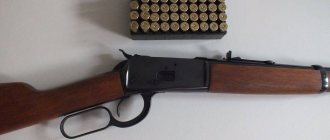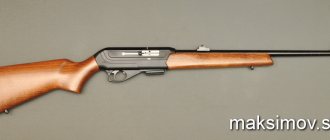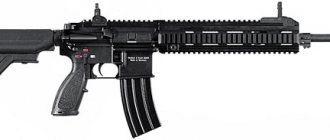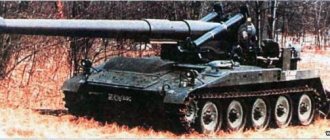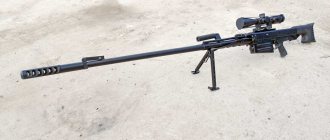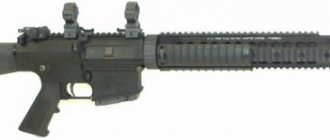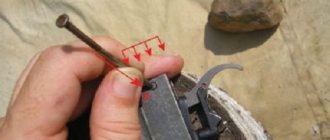Rifle CZ ZKM 452 SCOUT cal. 22LR
The CZ 452 ZKM is a classic bolt action rifle with excellent design. It is made in many versions.
Characteristic features of all versions:
- The CZ 452 ZKM is well balanced and therefore convenient for quick and easy aiming.
- Adapted to a wide range of shooting distances.
- Easy installation of optics on a rifle.
- Manage items that are easy to maintain.
- Adjustable trigger mechanism.
- The safety indicator indicates the condition of the trigger mechanism. Easy to disassemble, clean and routine maintenance, which can be performed without any tools.
- High degree of accuracy when shooting.
- Great service life.
- High functional reliability in all environments, even with ammunition from different manufacturers and with different types of bullets.
SMALL CALIBER RIFLE CZ 452
The small-caliber rifle is manufactured by Ceska Zbrojovka in Uherský Brod, Czech Republic. This is a large production where the traditions of gunsmithing are successfully combined with the most modern equipment. All weapons of this Czech brand have been successfully sold all over the world for a long time and have an undeniable reputation as durable, reliable and of very high quality.
GATE
The rifle's bolt consists of only nine parts: a stem, a firing pin, a mainspring, a rotary coupling, a rod, a safety catch, an ejector, a cartridge case and a leaf spring. The bolt stem is made of stainless steel using precision investment casting and subsequent machining. Its dimensions and weight are more consistent with a .308 caliber rifle than with a small rifle, but this is its only drawback.
The main advantages of this shutter are a huge margin of safety and the ability to be completely disassembled in the field. The stem has a channel for the firing pin, a shaped cutout with a forward protrusion and a groove for the reflector, a hole for the fuse rod, an annular groove for the leaf spring, cutouts for the ejector and the sleeve holder, as well as a recess under the bottom of the sleeve - a cup in the front part.
As in all other systems of this caliber, the bolt stem does not rotate, and the breech is locked and the firing pin is cocked by a rotary coupling mounted on it, made integral with the reloading handle. The manufacturing technology of the coupling is the same as that of the bolt stem - precision casting and machining. There are two symmetrically located lugs on the bolt coupling, the strength of which, according to the most conservative estimates, would be sufficient for the .223 Remington cartridge. The fit of the coupling on the bolt stem is sliding, the gap is no more than 0.03-0.04 m, which speaks of a high production culture and the “non-childish” concept of this weapon. The coupling also has a helical surface, which traditionally performs two functions - cocking the firing pin and protecting the weapon from being fired when the bolt is unlocked. The firing pin is a complex part with a channel for the mainspring, a groove for the safety rod, a trigger and a safety lug in the rear, as well as a striker in the front. The technology for manufacturing the firing pin is the same as for the bolt stem - casting and machining. On the examined example, the firing pin had minor damage, most likely due to aimless idle triggers.
The most interesting feature of the CZ 452 rifle bolt is the special installation of the ejector and cartridge case. They are installed in the longitudinal grooves of the bolt stem not on pins, but using L-shaped hooks and held in place by a C-shaped leaf spring installed in the groove of the stem. The advantage of such a solution can hardly be overestimated; it makes it possible to regularly thoroughly clean the stem parts! When installing these elements on pins, which is a common practice, removing the ejector for cleaning is impossible, since each pressing out of the pin breaks the hole and reduces the tension in its fit. It is enough to do this several times and the pin will spontaneously fall out of the hole.
Anyone who has shot from domestic small-caliber weapons knows how often the cartridge case fails to be removed even when the ejector groove is slightly dirty. Separately, it is necessary to say about the role of the sleeve holder. Some inexperienced shooters mistake this part for a second “backup” ejector, although its purpose is completely different - to hold the spent cartridge case in the bolt cup until it meets the reflector and is removed from the receiver. If for some reason the cartridge case holder fails to cope with its duties, the cartridge case ends up in the receiver and jams the bolt when chambering the next cartridge. Of course, there is no harm in this - they don’t go after a bear with small change, but it’s still disgusting.
Disassembling the rifle bolt is carried out in the following order. First, you need to lower the firing pin, for which you rotate the coupling relative to the stem, after which, holding the bolt firmly, recess the guide rod, resting it against some solid object and, holding it in this position, remove the fuse. The fuse rod in this design acts as a contactor, after removing which all that remains is to remove the guide rod, mainspring, and firing pin from the bolt stem, and then remove the clutch. Next, you need to use a thin screwdriver to pry the tip of the leaf spring and remove it from the bolt stem. After this, the ejector and sleeve holder simply fall out of their grooves. It is better to start assembling the shutter by installing the ejector and sleeve holder, which does not cause any difficulties. It is impossible to confuse these parts, since they have different widths (a trifle, but nice!). After installing these parts, you need to put the coupling on the bolt stem, then insert the firing pin into the bolt, and the mainspring into the firing pin. Next, you should install the coupling in the closed bolt position and insert the guide rod into the hammer, making sure that its groove is parallel to the hole for the fuse rod. After this, you must again recess the guide rod and insert the fuse into place, which is possible under a certain position. This requires minimal skill and succeeds, if not the first time, then certainly the second time.
RECEIVER
The rifle receiver is made of steel. You can talk a lot about the advantages of a light alloy for this main element of a weapon, in general this will be correct reasoning, but if the locking occurs on the receiver, using a light alloy for its manufacture is, in principle, bad form, regardless of the power of the cartridge used. The shape of the receiver is cylindrical - cheap and cheerful. The thickness of the receiver wall is more consistent with a rifle chambered for a magnum cartridge than with a small rifle. From the point of view of strength and safety, this is a huge overkill, but we should not forget that a large cross-section gives not only strength, but also enormous bending and torsional rigidity, and this is very good for accurate and stable combat. The receiver has dovetail slots for mounting optics. The standard guide width is 11 mm, which allows you to choose from a large number of brackets available on the market. On the right side there is a window for ejecting the cartridge case, and in the rear there is an annular groove that interacts with the lugs of the bolt clutch, and cutouts for installing the trigger mechanism. At the bottom there is a cutout for the magazine and three holes for mounting screws. The receiver is fitted with a liner, typical of most small bore bolt action rifles. The liner is made of steel by milling and chiselling and heat treated. Together with the liner there is a reflector, which is a low protrusion. A fixed reflector is the simplest and most reliable solution to the problem of removing a spent cartridge case outside the receiver. You don’t have to look far for examples - this is the well-known Kalashnikov assault rifle. At the bottom of the receiver there is a magazine shaft made of cast black impact-resistant nylon. This extremely technologically advanced material has long been used quite successfully in the weapons industry. Having a tensile strength approaching that of aluminum alloys, it is not susceptible to organic solvents, oils, does not crack in the cold and has a coefficient of thermal expansion equal to that of steel, which allows the use of steel reinforcement if necessary. In front of the magazine shaft there is a spring-loaded magazine latch, similar in design to the Kalashnikov one, only smaller in size - again, the simplest, extremely reliable and time-tested solution. STORE The rifle can be equipped with either a five- or ten-place magazine. The magazine is made of the same material as the magazine shaft - impact-resistant nylon. The magazine cover and feeder are made of the same material. The store is dismantled in a classic manner. In a magazine designed for .22 LR cartridges, the most delicate place is the top, responsible for the correct feeding of the cartridge from the magazine into the chamber. The fact is that when chambering a .22 LR cartridge, due to its short length, old-fashioned design and rimmed case, the rear part of it rises to the chambering line not under the action of the feeder spring, but with the help of two bevels located in front of the lips holding the cartridges . In order for the feed to occur smoothly and reliably, the geometry of these bevels must be maintained very precisely. In the case where the magazine is stamped from a steel sheet, a slight push is enough to slightly crush them, and the magazine ceases to function. The CZ 452 magazine is made of hard plastic and reinforced with steel reinforcement, similar to the technology used in Clock pistols. Until the moment when the plastic on the guide bevels is completely erased by a large number of shots, the magazine will work. This design is not afraid of shocks and impacts, and it does not rust. As for the magazine capacity, in my opinion, the five-round magazine looks more aesthetically pleasing, although its twice as capacious counterpart makes it easier to hold the weapon when shooting standing, being a kind of champignon.
TRIGGER
The trigger mechanism of the rifle is made in the image and likeness of the famous Wichester 70. The main advantages of this design are extreme simplicity, exceptional reliability and high quality of the trigger. In many ways, this type of trigger is a reference solution for rifle builders, similar to the Browning bolt-action design for automatic and pump-action weapons. It consists of a spring-loaded trigger and a self-release sear. In fact, there is not a single superfluous part in it, there is not even a body, since due to the fact that the trigger, as it were, covers the self-release sear on both sides, the axes of both elements can be located very high, almost on the same line. This allows you to drill holes for the axles in the receiver itself, without even making additional lugs on it, not to mention a separate body. In this mechanism, the sear performs two functions: holding the striker and limiting the movement of the bolt in the rear position. In order for the bolt to be removed when the trigger is pressed, it has a special pin that forcibly turns off the sear. The second advantage of this solution is the complete guarantee of release of the striker, regardless of the ambient temperature and the degree of contamination of the mechanism. The mechanism provides the ability to adjust the trigger force, for which you need to use a small key and narrow pliers to rotate the square nut, which presses the trigger spring mounted on the rod. On the examined sample, the trigger force was about 2 kg with a short and clearly noticeable trigger stroke. A long trigger spring with a large initial pressure is extremely important so that the trigger moves smoothly and evenly when pulled, and does not stop due to too much increase in force along its course. To make the descent as comfortable and smooth as possible, the engagement surfaces can be polished with the finest sandpaper and then lubricated with a grease containing highly effective anti-friction additives, for example, molybdenum disulfide. It must be remembered that when polishing the escapement, it is important not to fill the edges, for which the sandpaper is placed on a flat file. It’s hardly worth focusing on reducing the trigger force. In my opinion, when shooting from the hand, a heavier (about 2.5 kg) trigger with a pull seems to fix the weapon on the aiming line, preventing it from shaking. In addition, during a dry trigger without pulling, the shot occurs completely unexpectedly and the moment of its production is extremely difficult to synchronize with the moment of greatest stability of the weapon, which leads, I believe, to an increase in dispersion from unstable positions.
SAFETY OF USE
Any weapon by its very nature is a source of increased danger. I hope there is no need to explain to anyone that the caliber and power of the cartridge are not decisive here. The number of Joules does not particularly affect the rifle's ability to kill, determining only the quality and timing of the process. In our case, the energy of a standard .22 LR caliber cartridge is about 110-120 J, which is enough to penetrate the soft tissues of the body to a depth of approximately 35-36 cm. Considering that a .22 caliber bullet, as a rule, ends this mournful path at the bottom forward, then the maximum width of the wound channel profile is about 12 mm. I believe that what has been said is enough to understand how important confidence in the safety of these weapons is. Due to the nature of my occupation, I have had and still have to communicate quite a lot with a wide variety of rifles, and my experience has taught me to be extremely distrustful of any weapon in which I have not personally disassembled and inspected the trigger mechanism. The price and promotion of the brand do not matter at all; a catch can and should be expected from any unfamiliar weapon. What ensures the safety of the CZ 452? First of all, the rifle has a safety device located on the bolt that locks the firing pin. This is the second safest system after those that lock the hammer and trigger lever at the same time, but the simplicity and reliability of this device are beyond doubt. When putting the safety on, the striker is cocked by about 1 mm more, which makes turning on the safety more difficult, but it creates a guaranteed gap between the trigger and the sear, which should be enough in any case. The safety is turned on in a non-standard way - by moving forward, which is not particularly good, considering that the vast majority of “adult” rifles do this exactly the opposite. The second most important safety outpost is the trigger mechanism. I am categorically against the dry descent in all its guises also because in modern systems it is achieved by sharply reducing the size of the main engagement, sometimes to a completely absurd 0.3-0.35 mm. A person who claims that weapons are safe to use is simply on the other side of good and evil. In the CZ 425 rifle, the engagement is about 0.8 mm, which, in my opinion, is a little too little, but still enough so as not to expect a spontaneous shot every moment when the weapon is removed from the safety, or, which happens much more often, when removing from there.
SIGHTS
The fashion for optics and the improvement of optical sights themselves are gradually turning the traditional front and rear sights into rudiments. At the same time, with every decade, the art of shooting goes away with them. It is an art, not a craft, which, in my opinion, is the use of optics. I really like shooting without optics, and I certainly like weapons where the front and rear sights are a tool, not a vestige. Fortunately, the CZ 452 is fine on this count as well. The first thing that catches your eye is the exceptional quality and thoroughness with which its sights are made, the second is the extreme simplicity of bringing the rifle into normal combat, for which, in addition to, of course, cartridges, you only need a small screwdriver. Let's start in order. The rifle's front sight is mounted on a steel base pressed onto the muzzle of the barrel. This is now done so thoroughly and firmly mainly on rifles of African calibers. In this case, the barrel passes into the base of the front sight so imperceptibly that you have to look closely to notice the joint. In the upper part of the base of the front sight there is an inclined groove of the “dovetail” type, which decreases towards the muzzle, in which the front sight is installed. In this case, moving the front sight along the groove allows you to adjust the position of the STP in height. At the base of the front sight there are narrow grooves in which a spring fly guard made of thin sheet steel is fixed. This is perhaps the most successful version of this useful device, since, on the one hand, it is easy to remove, and on the other, its small thickness makes it practically invisible when aiming. Compared to some modern examples chambered for a similar cartridge, the rear sight of the 452 model is a work of art. The sight base is made of steel and pressed onto the barrel. Additional fixation is made with a pin. At the bottom of the rear sight base there is a round boss with a hole for a tightening screw, which is a stock stop. The sector-type sight is calibrated from 25 to 200 meters in 25-meter increments. Relocating the sight to a different distance is done simply and without any effort. Each position has a digital designation. In the rear part of the sighting bar there is a narrow transverse groove in which the rear sight itself with a semicircular slot is installed. Using two screws screwed towards each other, you can accurately adjust the horizontal position of the rear sight when zeroing the weapon. All parts of the sight are made of steel and carefully polished. The only drawback of an iron sight is quite typical for the vast majority of rifles - the rear sight is too close to the shooter's eye. Dear gentlemen gunsmiths! When will you finally understand that chasing an ephemeral advantage in aiming accuracy due to a longer aiming line does not lead to anything good! The rear sight blurs, and it becomes simply impossible to orient the weapon relative to the aiming line. On the display of a computer shooting simulator you can clearly see how the STP moves with a blurred rear sight, even for shooters who have high stability.
LODGE
The rifle stock is made of high-quality walnut wood in a fairly light shade and coated with polyurethane varnish. The shape of the stock is very comfortable, the rifle is quite usable. There is a notch on the neck of the stock. The selection of grooves for metal parts is made on a multi-spindle machine with numerical control with high accuracy. No traces of manual drafting were found. The stock is equipped with a plastic butt plate, a lower cylinder with a sheet metal trigger guard and sling swivels. The butt plate is a butt plate “even in Africa”, and there are no complaints about it, but the larva and swivels let us down. On such a well-made weapon, a trigger guard made of a bent strip of sheet metal with sharp edges looks very unsightly and greatly detracts from an extremely well-made rifle. If it were made from a casting along with the larva, this alone would add 100-150 dollars to the visual sense of the price of the product. As for swivels, this is another incurable disease of modern weapons. All manufacturers are well aware that a screw with a ring is not a swivel, since it constantly strives to unscrew itself from the wood, but they continue to stubbornly install them even on samples whose cost exceeds $2000. A normal swivel should have a long base and be attached to the tree with two screws.
BALANCING
The length of the rifle is 1080 mm, weight is 3 kg, the center of gravity is located approximately 500 mm from the butt plate. This is a complete mass-dimensional analogue of an average hunting rifle of normal caliber, which is very convenient for training before the hunting season. Measuring the moment of inertia relative to the butt plate also did not bring any surprises: it gave 0.96 kgm2. This value, again, is typical for an “adult” weapon, which is very good from the point of view of equivalence, but a bit too much for shooting while standing. When firing with open sights, a weapon with a similar moment of inertia is even more or less stable, but installing optics with a magnification of more than 2X will inevitably destabilize it due to the increased apparent angular velocity of the weapon's oscillations. Unfortunately, this rifle failed to repeat the result of the CZ 527 with its impressive 0.62 kgm2 at 3.9 kg weight with powerful optics, despite the presence of obvious prerequisites for this, such as a less powerful cartridge and the very purpose of the weapon.
GENERAL IMPRESSION
The design of the rifle is classic to the core. Sliding bolt, open adjustable sight, locking striker-safety, simple trigger mechanism. The overall impression is very favorable. This is a rather rare case when, after disassembling a weapon, you begin to truly appreciate and respect it. At first glance, the rifle does not make a particular impression: the phosphated receiver, stamped trigger guard and plastic magazine do not at all give it any additional charm. However, having begun to slowly, step by step, delve into the features of its design, you very quickly come to the conclusion about the deep thoughtfulness and rationality of the solution to every, even the most insignificant detail. FOR WHAT? If you read what they write about .22 LR weapons in the modern world weapons press, you get the clear impression that the “small stuff” is primarily an entertainment, training and sports weapon, intended either for initial shooting training or for performing sports exercises . But if you look closely at the role of this class of weapons in various weapons cultures, you get a more complex and ambiguous picture. In North America, weapons chambered for the .22 LR cartridge are most often the first weapon that falls into the hands of a person aged 7-10 years. Having acquired the first skills in handling weapons, an American teenager usually switches to a center-fire rifle chambered for .224 caliber and after that to normal-caliber rifles and shotguns. Based on this, a typical American “small thing” fits perfectly into the concept of a Christmas or Easter gift: it should look attractive, be extremely light and compact, the length of the butt should be comfortable for a child, and the price should be suitable for dad’s wallet. The vast majority of .22LR rifles in the United States are sold in department stores in the hardware or children's sporting goods departments. In old Europe - the homeland of this type of weapon - the situation is completely different, both differences in traditions and in weapons legislation are reflected here. To put it simply, this or that weapon can play the role of a mass educational tool only if it is allowed for free sale. Therefore, if a small-caliber rifle cannot be bought as easily as a stick of sausage, its main use becomes shooting sports, most often developed on the basis of specialized organizations - shooting clubs. The reason for the dominance of the .22 caliber cartridge in sports is, first of all, its low cost with high accuracy of fire, as well as the simplicity of the shooting range. Indeed, not everyone in densely populated Europe can afford such a luxury as a 300-meter shooting range. In the Soviet Union, the situation was more similar to Europe - a significant portion of .22 caliber cartridges were burned by athletes, achieving brilliant results in international competitions. However, something else is important: historically, the “small gun” in Russia is a weapon for hunting. There are many reasons for this. Firstly, a small-caliber rimfire cartridge is a very practical thing in Russian hunting conditions. Lightweight, cheap and quite capable of killing small game, it is equally good for fur hunting, survival in the forest and small-scale poaching, the latter being the reason for the ban on its use in hunting in the European part of Russia. By the way, the Russian hunter is far from alone in his grief; similar restrictions apply almost throughout Europe and in some states of the USA. The extreme hunting ability of a small-caliber rifle in the hands of an experienced shooter, combined with the secrecy of shooting due to the weak sound of the shot, can undermine the numbers of many hunting species.
MAKSIMOV.SU
CZ-452 Style
with Nikon MONARCH 5 5-25×50 SF ED optical sight. Thanks to the selected rings, the scope fits perfectly on the weapon
Czech weapons are very popular in our country.
Moreover, thanks exclusively to hunting rifled weapons. Yes, in our market you can also find CZ-USA Ringneck smooth-bore double-barreled shotguns (a Czech model, it seems, for the USA, either Turkish or Czech-made), but this is the best example of how not to make a gun.
You can also buy a Czech fenced assault rifle CZ SA Vz.58 chambered for 7.62x39 mm. This is a very interesting similarity to our AKM, a legacy of the Warsaw bloc. Sometimes the self-loading “small thing” CZ-512 is found on sale.
But all this
almost exotic, so we associate the letters CZ with classic bolt-action rifles. The hunters nicknamed them “ChiZa” or “ChiZet”. And not so long ago, these weapons had a good ratio of retail cost and quality.
Hunting with CZ-452
with installed KAHLES KXi 3.5-10x50 L
Now the situation has changed,
prices for zbroevka have soared, the Czechs themselves have not yet decided on their sympathies - towards the EU or, ultimately, towards Russia, but their rifles are still sold here. “ChiZets” are similar in appearance to “Mauser”, which for many is a compelling argument.
Wherein
Czech rifles usually shoot very well. One of the most interesting models produced by Ceska Zbrojovka is the small-caliber rifle CZ-452, which will be discussed in our article.
CZ-452 Style
During the Second World War
the Czechs under occupation conscientiously made military weapons for the Wehrmacht, incl. — Mauser rifles 98k. They made so many of them that when assembling rifled hunting weapons of normal calibers, the Czechs still use wartime bolt groups.
CZ-452 Style
Industry
Czechoslovakia by the end of the 1930s. was one of the best in Europe, which was very useful to the Germans when preparing the invasion of the USSR: Czech factories produced everything from armored vehicles to small arms. What is noteworthy is that in the Czech Republic (after the Munich Agreement of 1938, Slovakia was separated by the Germans, and in 1939 the Germans occupied the remaining Czech Republic) there was not a single revolt against the occupiers.
In one of
In foreign publications, I once read a remarkable phrase: “The Czechs are not afraid to consider themselves Europeans.” And I thought for a long time - was the author of that article trying to pay our Slavic brothers a compliment or just laugh at their next attempt at “integration into Europe”?
Shooting from a CZ-452 Style with an old VOMZ “Pilad” 4x32 optical sight.
For hunting, such a sight for the eyes, for “paper” is completely insufficient
But
we must pay tribute - today the Czech media are increasingly publishing materials that run counter to Western anti-Russian rhetoric. Whether they prudently pursue political interest or economic interest – it doesn’t matter. The main thing is that the Czech Republic clearly does not want to break off cooperation with Russia. And this is important for our hunters.
design of the CZ-452 bolt of other small-caliber rifles. As you can see, there is no smell of Mauser-98 here
CZ-452 ZKM
This model
Available in several versions: Classic, Style, Varmint, Special and Junior, with stocks made of wood or plastic, with different barrel lengths and thicknesses, with and without open sights. There is a modification for the American market (with the coveted thread on the muzzle of the barrel), and there is a maximally simplified model.
CZ-452 Style
Rifles CZ-452
are chambered for .22 LR and .22 WMR. For every taste and budget. All this variety has little effect on the final result, but the consumer appreciates the opportunity to choose. The situation with cartridges is still difficult. The .22 WMR cartridge is not produced by our factories and is now more expensive than the 7.62x54R cartridge.
In addition
we still need to look for it. Which was the reason for the massive dumping of “little things” for this ammunition. But rifles chambered for the “regular” .22 LR cartridge appear much less frequently on the secondary market – the reason is also in the cartridge. This time – widespread and easily accessible.
Somehow I came across a note,
which claimed that the Australian magazine Sporting Shooter supposedly called the CZ-452 "the best small-bore rifle in the world." I don’t know what they compared “Chiza” to, but such a statement can hardly be considered correct.
Cause
It’s simple - there are serial models (both ours and those made in the West) that, in terms of their total performance characteristics, are at least in no way inferior to the CZ-452 model, and in a number of parameters and price/quality ratio are significantly superior to it.
CZ-452 Style
Design Features
About Czech “little things”
Quite a lot has been written over the past 10-15 years. Basically everything is to the point, but there are some things we can’t agree with. For example, with statements that the “452nd” model is a smaller copy of the “Mauser” and so on. To say that the design of the CZ-452 is based on the Mauser rifle mod. 1898 is indeed not entirely correct.
The thing is
, that the Mauser factory, even before WWII, produced a huge number of models of sporting small-caliber rifles: in D. Speed’s book “The Mauser Archive” alone, I counted more than 15 independent designs chambered for the .22 Lr cartridge. And models created specifically on the basis of the bolt group arr. 1898, have significant differences from CZ-452. All that remained of the Mauser in the Czech rifle was essentially the bolt turn.
CZ-452 Style
Doesn't correspond to the truth
and the frequently encountered statement that all existing “small ones” have a fixed bolt stem. This is wrong. Before World War II, Germany produced training 5.6-mm Mausers for the Wehrmacht with a bolt system mod. 1898, except perhaps without the front lugs. But let's return to CZ-452.
Nikon MONARCH 5 5-25×50 SF ED sight
on the CZ-452 rifle in the “Lux” version, with a walnut stock and open sights
Design
This rifle has many positive features. Of course, the Czechs did everything to minimize the cost of these weapons. This applies to both the materials used and the quality of processing and coating of internal and external surfaces. On the other hand, the Czechs do not position their “small” and medium-caliber rifles as some kind of exclusive (this is already the prerogative of our sellers).
CZ-452 stands out
a fairly powerful receiver, which is comparable in size to the receiver of the CZ-527 model chambered for .223 Rem. Thanks to this, the “small thing” is perceived almost like an “adult” rifle both in the hands and visually. An 11-mm dovetail is milled on top of the receiver, which allows you to easily install an optical sight on the rifle.
Usually
it is so. But with the “black” CZ “Style”, which illustrates our article, I was frankly unlucky - the “dovetail” on its box turned out to be misaligned with the bore.
Problem
was solved by placing a piece of tin on one side under the grip of the front ring, thanks to which the sight along the horizon was brought to “zero” almost like the Kochetov bracket arr. 1942 on a three-line sniper. But, as they say, the sediment remained.
Russian cartridges
used in shooting rifles
Thanks to
With symbolic recoil, even those sights that quickly “die” on weapons of larger calibers can be installed on “small” ones. The same applies to rings; here you can safely buy cheap Chinese crafts for 500-700 rubles per pair. However, without more or less decent optics it is impossible to unlock the potential of a 5.6 mm rifle.
On two CZ-452
that you see in the photographs, over 6 years of operation, many sights have been used: from the popular Russian “Pilad” 4x32L and Chinese BSA to Kahles KXi 3.5-10x50 L and several Nikon models. The main part of the photographs used in the article shows a representative of Nikon’s flagship line on rifles: the Monarch 5 5-25×50 SF ED model.
Exactly
Such a sight, which has a great “picture”, good “mechanics” and a thin ballistic reticle with the ability to make wind corrections, is the optimal choice for shooting “on paper” from a small-caliber rifle. We will dwell on this further below.
Rifle bolt
made using precision casting technology, followed by processing on a milling machine.
The shutter is completely disassembled “on the knee” and consists of 9 parts. Locking is carried out on two symmetrical lugs of the rotary coupling, made integral with the bolt handle. Nikon MONARCH 5 5-25×50 SF ED reticle on the target at various magnification settings
On a rifle
With a black plastic stock, at first there were problems with the release of the striker. To be more precise, the weapon was completely inoperable. When buying a rifle in a store, I didn’t want to click idle, and after registration, when a problem was discovered at the shooting range, I had even less desire to bother with returning it.
How
the rifle generally passed the quality control department at production and subsequent control shooting in Russia - one can only guess. I had to remember my school labor lessons. The groove in this very coupling had to be bored out with a file right at the shooting range, using an unkind word for the Czechs with their “epitome of quality,” as it is written in an advertisement for CZ rifles.
This group was obtained
when shooting at 50 m
Let's shoot
Plastic store
For 5 rounds, the CZ-452 comes with only one. Separately, for ridiculous amounts of money, you can buy spare magazines, incl. – for 10 rounds and even steel ones.
Can
and make some handicrafts: buy for 100-150 rubles a plastic magazine from the “small” TOZ-78, add the missing dimensions to it from epoxy resin or “popsicol”, grind it all according to the original model and use it.
Certainly,
such a home-grown product will not look very beautiful. But if you need to shoot, and not admire the original spare magazines, then such a surrogate will do for a sweet soul.
About the CZ-452 trigger guard
You can easily cut yourself - the chamfers from the edges of the chopped strip from which the bracket is made are not removed. By the way, this bracket rusts terribly even in a safe (and the rifle itself too), this must be kept in mind.
Shooting from a CZ-452 Style
from a bipod at a distance of 50 and 100 m
Charging problems
does not cause anyone. The magazine fills without difficulty and is inserted with a clear click. The shutter is quite rigid and moves with a slight rattle. The reason is easy to discover - the receiver channel is cut carelessly, there are traces of the cutter everywhere.
If you
If you are not ready to put up with this and have at least some metalworking experience (the level of the Soviet school is more than enough), then it is better to grind the bolt right away. It is advisable to remove all the chamfers in the receiver and sand it a little.
Despite the low rings,
the cleverly curved shutter handle does not interfere with the rather large eyepiece of the Mornach.
The muzzle of the CZ-452 Style barrel
has rough machining
Descent to CZ-452,
when compared with German pre-war “little things” (or with domestic modern models), it is simply disgusting and varies from instance to instance.
USM
clearly needs improvement - replacing springs and polishing contact surfaces.
This is not difficult to do, but it requires care and precision in your work. The CZ-452 Style is ready to fire. When using a small-caliber rifle for the intended purpose, a rangefinder is simply necessary
Maybe
, in nature there are CZ-452s with more or less sane trigger characteristics. But this does not apply to the copies illustrating this article. However, with good optics, rifles quite reliably produce groups of about 35-50 mm at 100 m.
When shooting it was discovered
that the ejector of one of the CZ-452 does not remove every cartridge case from the chamber.
Moreover, the extractor grips slipped not only from the flange of Soviet-made cartridges: cartridges from completely “fresh” Klimov cartridges also remained in the chamber. And, what was completely confusing, the cartridge cases of Czech-made cartridges were thrown out every other time. The bolt is open, the cartridge is in the feed line
And all this
- on the “Style” with a plastic stock, although problems with extraction periodically appeared on the second, “luxury” rifle. Inspection and cleaning of the ejector grooves did not yield anything - the problem turned out to be precisely the shape of the extractor tooth and a rather weak spring.
Cured
again, this is done with a file and not completely - you need to make a new, stiffer spring. Do you remember the common saying that people love to apply to Russian products: “after assembly, finalize with a file”? So, this is about the CZ-452.
Normal case non-ejection
from the CZ-452 chamber
Removing the sleeve
The sleeve at the moment of impact on the reflector
What's in the "chezetka"
I liked it without any reservations, it’s an open sight. Not some kind of flip rear sight “a la PPSh”, but a full-fledged sector sight, cut to 200 m. In combination with a convenient front sight, the CZ-452 “bar” can be used to shoot comfortably and accurately at any reasonable distance.
Sector sight of the ChZ-452 rifle
Not everyone
and small cars don’t always need optics, which was taken into account by Czech designers. In the simplified version of the rifle, the open sight is completely primitive.
Same
I was on my old Izh-22 tire during my happy Soviet childhood. In the “style” and “varmint” variants (and on rifles intended for export to the USA) there is no mechanical sight at all - only optics can be installed.
Rifle front sight
When disassembling the rifle
it is clearly visible that its trigger mechanism is not at all similar to the classic trigger mechanism of the 98th Mauser. Despite advertising assurances of the “excellent trigger” of the CZ-452, Western Internet sites offer “sports” or simply sane versions of the trigger for this rifle.
Store shaft
made of durable plastic. The magazine itself is securely fixed in the shaft with a simple spring-loaded latch. The miniature safety is located on the bolt, has two positions, is quite convenient and reliably locks the firing pin.
Disassembly of CZ-452
in “Lux” version
Disassembling the rifle
Conclusion
To summarize what has been said
in just a few words, the CZ-452 is a good rifle.
It has a classic and recognizable design, good accuracy and ample opportunities for creative modifications. The only thing that spoils the impression (apart from the flaws in processing and the lousy trigger) is the high price of the rifle. Bottom of the rifle
If consider
that CZ weapons in Europe are cheap consumer goods, the cost of small-caliber Czech rifles in Russia is objectively quite high: in the spring of 2016 it was about 40 thousand rubles, depending on the region and version.
Butt plate
Not all hunters can afford this.
But you can follow the path of least resistance and without any problems, for a few thousand rubles you can buy an old Soviet “small gun” like the TOZ-17, which will shoot no worse than the CZ-452. The currently scarce Tula TOZ-78 shoots at least as well as the Czechs.
But,
For the sake of objectivity, we must admit that the Czech “small-caliber” is still a really nice and generally well-made rifle. Which is the determining factor for many buyers.
The shutter is open. Receiver from the inside. The steel magazine feeder, the reflector on the bottom of the box and the double extractor are clearly visible
Operation of the fuse.
The safety is off when the red dot opens, "Danger!"
The article was published
in the magazine “Master-Gun”, May 2016, No. 5 (230)
